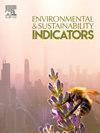Adapting farm-level sustainability assessment: Challenges for Florida strawberry agriculture
IF 5.4
Q1 ENVIRONMENTAL SCIENCES
引用次数: 0
Abstract
This paper evaluates the applicability of farm-level sustainability indices for measurement and identification of community-oriented issues in a high-value, rapidly urbanizing agricultural region. Agricultural sustainability indices must be measurable, operational, and tractable to be effective. As rural communities develop, it is paramount for agriculture industries, governments, and researchers to have effective frameworks for assessing sustainability.
We apply the Initiative for Sustainable Productive Agriculture's (INSPIA) indicator index as an assessment tool and Florida strawberries as an example industry. INSPIA's index is farm-level and ideally applied based on primary data (INSPIA, 2024). Cost, time, and confidentiality concerns often limit primary data collection, so we assess the indicators with secondary data. The accessibility of secondary data is crucial to evaluate communities, industries, and regions over time.
Communities in the region face pressures due to climate change, urbanization, and globalization and could benefit from effective sustainability assessment to track and evaluate their efforts. We find 87.8% of the variables required to evaluate INSPIA's indicators have measurement issues due to scope, compatibility, and data availability. The measurement issues represent index limitations but especially highlight the dearth of official (or even accessible) agricultural data available in the United States. More secondary data, particularly for specialty crops and rapidly urbanizing environments, and more tractable assessments are needed to enable accessible large-scale replication. Despite these issues, 51.6% of the indicators can be measured, if imperfectly, and provide a snapshot of the pressures on a community in transition.
适应农场层面的可持续性评估:佛罗里达草莓农业的挑战
本文评估了在一个高价值、快速城市化的农业地区,农场层面的可持续性指标在衡量和识别社区导向问题方面的适用性。农业可持续发展指标必须是可测量的、可操作的、可处理的,才能有效。随着农村社区的发展,对农业产业、政府和研究人员来说,拥有评估可持续性的有效框架是至关重要的。我们采用可持续生产农业倡议(INSPIA)指标指数作为评估工具,并以佛罗里达草莓为例产业。INSPIA的指数是农场层面的,理想的应用是基于原始数据(INSPIA, 2024)。成本、时间和保密性问题往往限制了主要数据的收集,因此我们用次要数据评估指标。随着时间的推移,辅助数据的可访问性对于评估社区、行业和地区至关重要。该地区的社区面临着气候变化、城市化和全球化带来的压力,可以从有效的可持续性评估中受益,以跟踪和评估他们的努力。我们发现评价INSPIA指标所需的变量中有87.8%由于范围、兼容性和数据可用性而存在测量问题。测量问题代表了指数的局限性,但特别突出了美国官方(甚至是可获得的)农业数据的缺乏。需要更多的二手数据,特别是关于特种作物和快速城市化环境的二手数据,以及更易于处理的评估,以实现可获得的大规模复制。尽管存在这些问题,但51.6%的指标可以衡量,如果不完美的话,并提供了转型期社区压力的快照。
本文章由计算机程序翻译,如有差异,请以英文原文为准。
求助全文
约1分钟内获得全文
求助全文
来源期刊

Environmental and Sustainability Indicators
Environmental Science-Environmental Science (miscellaneous)
CiteScore
7.80
自引率
2.30%
发文量
49
审稿时长
57 days
 求助内容:
求助内容: 应助结果提醒方式:
应助结果提醒方式:


